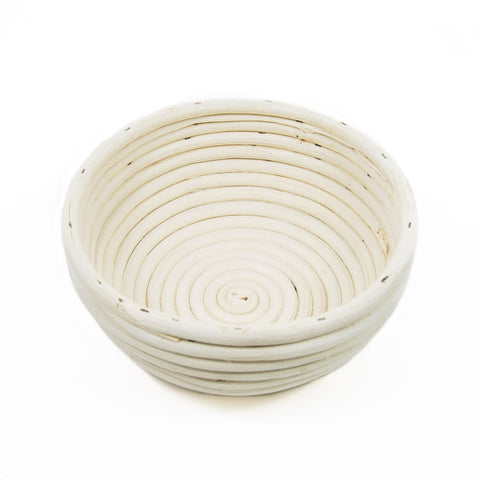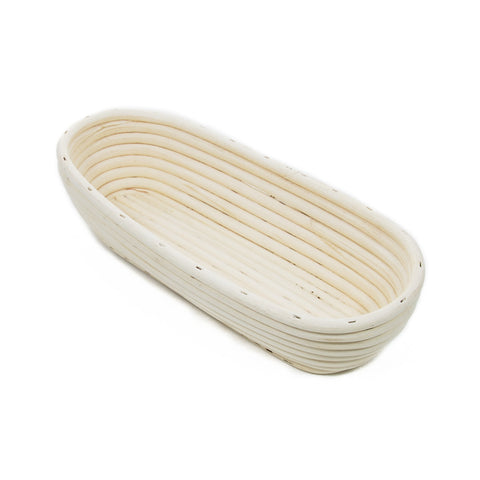How to use a banneton or proofing basket

What is a banneton?
A banneton is a proofing basket that is made out of natural materials such as cane or wicker used for proofing dough.
Browse our range of bannetons and proving baskets.
Why do you need a banneton?
When a dough is not baked in a tin, a banneton is used to keep the shape of the dough, during its last proof. A banneton is particularly important when using a high hydration dough, sourdough, long fermented doughs or simply because we like the artisan look of a loaf.

Why does my banneton stick?
This is a big question. The problem arises when bannetons are new. Once bannetons have been seasoned and have gained a share of flour that sticks to the gaps between the cane or to the cloth of the lined baskets, they are a cinch to use. Here are the dos and don’ts for both cane, and cloth-lined bannetons:
How to season new cane banneton (unlined)
- New cane bannetons need to be first damped. This does not mean immersed in water, instead, spray with water all over the inside of the banneton right up to the edges.
- While the banneton is damp add a generous handful of flour and rotate the banneton in order for the flour to cover the dampness and stick to the cane, and the gaps in-between.
- Leave the banneton for a couple of hours to let the flour dry. This layer of flour will now act as your lining.
- When you are ready to use the banneton add more flour, at this newly stage be stupidly generous with the flour.
- Once the dough is turned out if you have added too much flour, a little trick is to use a dry pastry brush to gently remove some of the excess flour. Doing this will erase some of the cane markings, but remember you are only doing this for the first two loaves you bake. After that the banneton will be seasoned and you can use less flour.
How to season a lined wicker or lined cane banneton
- Do not dampen the cloth of a lined wicker or cane banneton. The reason being is that the cloth will stay damp throughout the proofing, absorb the flour and begin to fuse with the surface of the dough, causing it to stick.
- Before using for the first time all you need to do is to liberally add flour to the linen, covering it as much as you can.
- Before putting the dough in the lined basket cover the dough with a good layer of flour too.
- The over-use of flour for the linen and dough is only for the first couple of loaves. Thereafter the cloth will have flour embedded acting as your non-stick.
- Do not wash the cloth between each bake, the flour needs to dry and stay put. A tapping to shake excess flour is enough.

MORE: Shop all bread making ingredients and equipment here
What flour do I use with a banneton?
- Different bakers use different flours or often a mix of flours. Wheat, rye, rice, and semolina are popular choices.
- A popular combination is 50/50 of wheat and rice flour, another is equal amounts of flour and semolina.
- I have used a mix of white and wholemeal flour.
- I would not recommend using only rice flour or only semolina as both can be too granular in texture. There’s a need for some finer flour to inhabit the crevices. A second reason is that some of the granules will not dissolve, and these will adhere to the crust like sand.
Tips for using a new banneton
Apart from dusting and more dusting with flour as described above, here are some additional suggestions:
- When dough is proofing do not cover with plastic as it creates a hot moist environment and raises the likelihood of sticking.
- For the first couple of bakes don’t make a dough with high hydration. A 70% hydrated dough is ample. Move up the hydration as the banneton wears in.
- Don’t let the dough rise all the way up to the edge of the banneton. Fully risen doughs tend to stick to new bannetons.
How to look after a banneton?
- After using the banneton, tap out any excess flour and let it dry completely in an airy place.
- All bannetons should be kept in a dry and ventilated place, ie not in a bag or stuffy drawer. If they are kept in an enclosed environment stacked with other bannetons there’s a high chance of mould appearing.
How to clean a banneton?
- As a general rule don’t wash a banneton.
- Soaking through the cane banneton will discolour and most likely distort the shape.
- Once dried if you need to rub off excess flour use a clean dry brush to remove it.
- For home bakers who can not tolerate the ‘no washing’ rule, buy the wicker lined bannetons or use a liner in the cane ones. After some bakes you can wash the linen and re-season.
- When bits of dough stick to the cane, the best time to remove it is soon after turning out dough, while the dough is damp and easily removable with your fingers.
The best bannetons to buy:
Feeling inspired? read Azelia’s Ultimate Guide to Flour here, or shop all baking ingredients. Or browse our range of bannetons and proving baskets.






